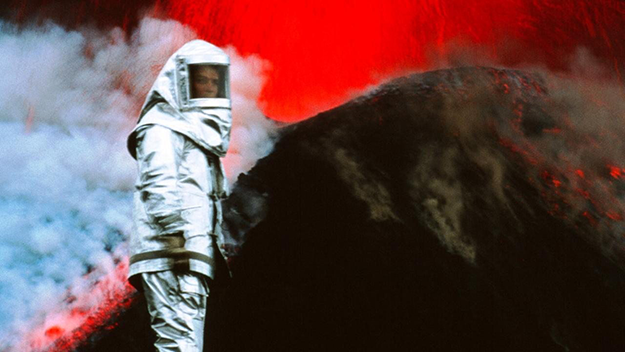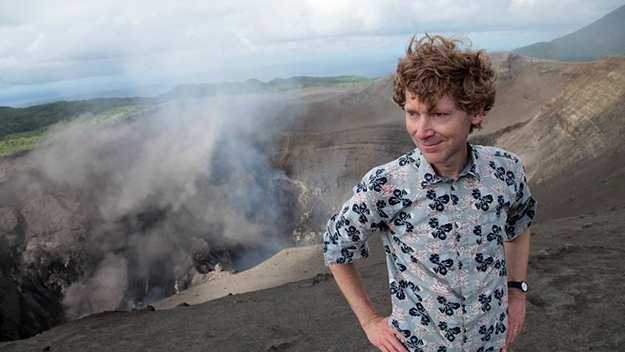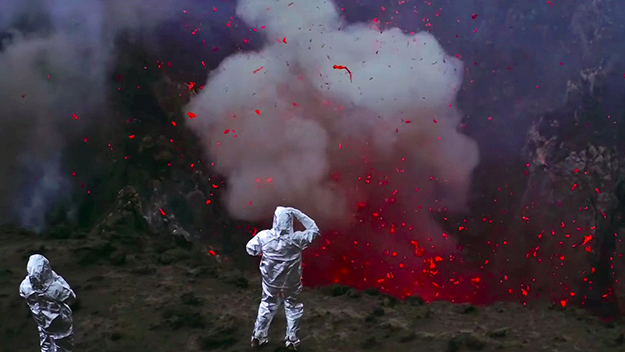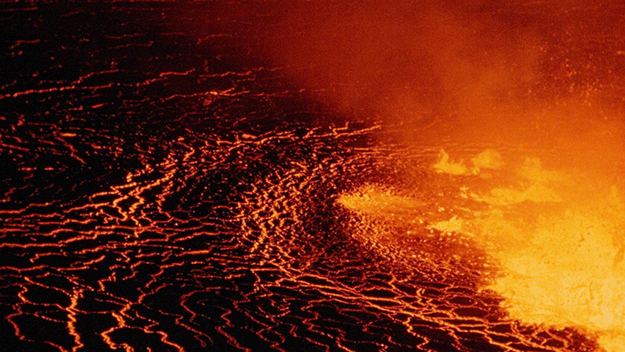Film of the Week: Into the Inferno

Werner Herzog’s latest feature, Into the Inferno, is about volcanoes, and if you’ve seen any of his recent documentaries, you’ll know that hearing the director utter the word “volcano” in that sepulchral Bavarian accent is itself one of the film’s selling points. Ever since Herzog achieved a new popularity as an accessible and highly idiosyncratic documentarist—the breakthrough being 2005’s Grizzly Man—his austere voiceover prognostications on the piddling wretchedness of the human condition have been one of his cinema’s prime appeals. Even before that, going back to his 1970s documentaries, Herzog has presented himself as a kind of peripatetic seer, his compulsive globetrotting forever taking him wherever the human condition seemed most precarious and nature most unforgiving. To increasing commercial success, he’s marketed himself as an Indiana Jones of imminent apocalypse, a David Attenborough of despair, a philosophizing Jacques Cousteau of—to use a characteristic phrase, one he memorably uttered in 1992’s Lessons of Darkness—“impending doom.”
The voice, and its pronouncements, have fossilized over the decade into a repetitive shtick, and one that can sometimes obscure what’s most impressive about the pictures that they accompany. A case in point is Into the Inferno, the director’s second recent documentary release, closely following his disappointing inquiry into the Internet, Lo and Behold, Reveries of the Connected World. Unlike that film, which too often skimmed over familiar terrain, Into the Inferno has a great deal of fascinating, indeed hair-raising material to show us. It was made in collaboration with Cambridge University professor of volcanology Clive Oppenheimer, author of Eruptions That Shook the World. Herzog’s first meeting with Oppenheimer, recapped here, took place in Antarctica, during the filming of Encounters at the Edge of the World (2007), another film that was crammed with material mesmerizing in its own right—if you like, the chilly yin to this film’s fiery yang.
Oppenheimer comes across as a politely earnest moon-faced, curly-haired man-boy, like a hyper-qualified Harpo Marx. He knows volcanoes, their science and their history, while Herzog knows how to complement such knowledge with myth and metaphysics. The director is interested in what volcanoes might mean in different cultures, and wherever he follows Oppenheimer, he seizes on the legendary or mythical qualities which different peoples have attributed to their eruptions. “What we were really chasing,” Herzog’s comments in voiceover, following a tranche of hard geographic data from Oppenheimer, “was the magical side—the demons, the new gods.” Of course Herzog’s attention gravitates instantly to one of the odder of those gods—the mythical American GI “John Frum,” revered as a spirit on Vanuatu’s Tanna Island. One day, the islanders believe, John Frum will return, bringing “copious cargos of consumer goods”—Herzog utters this phrase with a faint tinge of disapproval, like one who frowns on consumer goods whether coveted on Tanna or in Tallahassee.

There’s plenty of hard science, of myth and indeed of exotic travel here—any Herzog film these days tends to come across like National Geographic with a supplement of the Tibetan Book of the Dead. This film explores volcanoes around the globe—living and extinct, flaming magma-filled pits as well as the vast crater lakes they have left behind. It visits Korea, Iceland, Ethiopia, Indonesia, Vanuatu; it also briefly revisits Herzog’s 1977 film La Soufrière, about a volcano on Guadeloupe, and a man who refused to run away from the forecast eruption. On Ambrym Island, Vanuatu, village chief Mael Moses tells what he once witnessed in a lava-filled crater: “I saw people in that fire . . . cooking their food in there.” Moses points out that he isn’t related to the volcano, but his brother is: he’s so intimate with it, in fact, that it’ll even light his cigarette (Herzog delights in such touches, where the infinite meets the everyday). At the end of the film, Chief Moses confidently imagines volcanoes engulfing the world: “Everything will melt.” You sense Herzog’s pleasure at discovering an apocalyptic kindred spirit.
On the shores of Lake Toba, Indonesia, the world’s largest crater lake, Oppenheimer tells of the eruption there 74,000 years ago, apparently releasing enough pumice to bury every inhabitant of the United States to head height—a wonderful conjunction of the superlative and the surreal in nature. By Lake Toba, a local man has been inspired to build a Roman Catholic place of worship supposedly shaped like a dove, although it resembles another entirely—hence its local nickname, the “Chicken Church.” On Westman Island in Iceland, Oppenheimer evokes 1783, when the entire landscape burst into flame, making the headline-making eruption of Eyjafjallajökull in 2010 look like a popping zit. This is a great opportunity for Herzog to recite a passage from the ancient Icelandic manuscript, the Codex Regius: “From the mighty gods, the engulfing doom…” (the director made brilliant, and no doubt lucrative, use of his baleful delivery as the villain in Tom Cruise vehicle Jack Reacher; it can’t be long before some horror movie enlists him as the voice of an ancient Sumerian grimoire).
Always on the lookout for the sweet spot where elemental phenomena intersect with oddball characters, Herzog takes us to a dig in the Afar Region of Ethiopia, the hottest place on earth. Here the film veers slightly away from volcanoes per se to dally with a human volcano, effusive palaeoanthropologist Tim White, who could easily be Tommy Lee Jones or J.K. Simmons roaring away under that baseball cap with attached scarf: “Now it’s a matter of going to the casino and rolling the dice . . . Every single piece of bone is a keeper . . . Viva Las Vegas!”

Herzog loves a digression, but sometimes his roving interest gets the better of him. It happens that a British team of volcanologists is collaborating on a project with North Korean colleagues on Mount Paektu, considered the mythical birthplace of the Korean people; so Herzog seizes on a rare opportunity to muse on the strangeness of life in the Democratic People’s Republic. As a group of uniformed university students in peaked caps and tunics heartily serenade the mountain, Herzog comments: “Everything is different in North Korea. Imagine if these were students at a campus in California.” Well, yes, imagine.
In this section, Herzog hits a bedrock of absolute banality. I found myself thinking for a moment what a shame it was that he was only passing through; imagine an entire Herzog film that gave him the space to extrapolate more fruitful insights into life in the DPRK. You quickly become glad he didn’t make that film: looking at the log cabin once inhabited by “Eternal Leader” Kim Il-Sung, Herzog considers it the equivalent of “the stable in Bethlehem”: “the propaganda appears to create a quasi-religious experience.” He shows us an astonishing song-and-dance display with a cast of thousands, then comments: “In all this display of the masses, I find an underlying emptiness and solitude.” Much of the Korean digression takes us far away from the theme of volcanoes, but that doesn’t matter so much; what does matter is that the real emptiness here lies in the platitude of Herzog’s aperçus. He’s relying on his trademark “Dies Irae” delivery to confer profundity on them, but he says little that any TV travelogue host couldn’t tell us.
Years ago, Herzog coined the phrase “ecstatic truth” to describe a modern equivalent of the quality of the Sublime that fascinated poets, painters, and philosophers in the Romantic age of the late 18th and early 19th centuries: Herzog himself from film to film has metaphorically adopted the heroically forward-gazing stance of the figure in Caspar David Friedrich’s 1818 painting Wanderer Above the Sea of Fog. But while earlier Herzog films genuinely achieved ecstatic truth in their filmic textures, the absolute visual matter-of-factness and refusal of personal style in much of his recent work—its functional Discovery Channel flatness—means that the spoken word is often given the job of conveying ecstasy. Verbalized, however, that ecstatic insight seems forced, awkwardly imposed. You can’t help feeling that, if Herzog were to withdraw a little from his films, at least as commentator, he might find a greater eloquence in the images themselves.

In this film, at any rate, he at least allows the volcanoes to speak for themselves. For the most part, he and long-standing DP Peter Zeitlinger simply scan landscapes or point their camera at talking heads, establishing location in a generally unshowy way and allowing Oppenheimer to interview people personably and informatively. This, at least, serves as a foil for the irreducible magnificence and awesomeness—for once, we can use the word 100 percent literally—of the volcano imagery itself. On Lake Toba, grey plumes of smoke and dust rise up like nuclear mushrooms. In footage captured by legendarily audacious duo Katia and Maurice Krafft, a person in a silver suit stands in front of a wall of cascading flames; we then learn that the couple were killed by a “pyroclastic flow,” an avalanche of superheated gas and rock. All these images are genuinely sublime and imposing in themselves, and don’t need to be enhanced either by Herzog’s commentary or by the accompaniment of Russian Orthodox choirs, Vivaldi, or Baroque composer Heinrich Schütz.
But if there’s such a thing as the vocal equivalent of a money shot, then it comes right at the end, when Herzog delivers his trademark Lord-what-fools-these-mortals-be routine. Over vistas of churning red magma, he intones: “This boiling mass is just monumentally indifferent to scurrying roaches, retarded reptiles, and vapid humans alike.” He speaks himself with the Olympian contempt of a volcano god himself, or the contempt of a filmmaker who knows that we caviling critics, scurrying roaches as we are, can say what we like—the unstoppable flow of Herzog’s increasingly self-parodic discourse rolls on, conquering all in its wake, and people will still pay to hear it.
Jonathan Romney is a contributing editor to Film Comment and writes its Film of the Week column. He is a member of the London Film Critics Circle.







